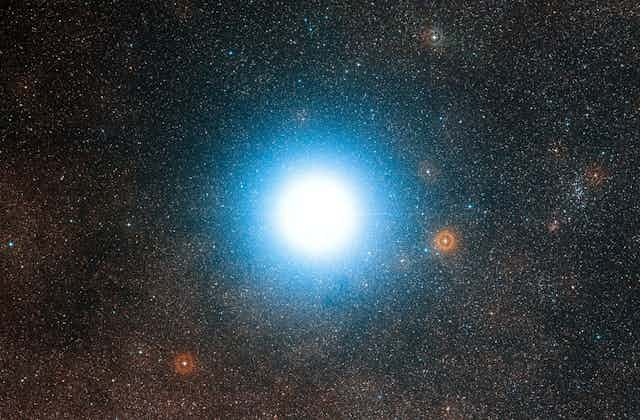Earlier this week, a Swiss-based team searching for planets outside our solar system (exoplanets) published a paper in Nature announcing the detection of an Earth-mass planet orbiting the star Alpha Centauri B.
The idea that one or more planets might orbit the star system closest to Earth (albeit more than 4 light years away) has been a favourite subject of science-fiction writers for decades. It is no surprise, then, that the tantalising combination of “Earth-mass” and “Alpha Centauri” has piqued substantial interest among astronomers and the general public.
The candidate planet – creatively named Alpha Centauri Bb – is only 0.04 Astronomical Units (AU) away from its host star – that is, 0.04 times the distance between Earth and the sun – making it ten times closer to its star than Mercury is to our sun.
This means the planet should be ludicrously hot, ruling out any chance of life existing there. It also has the fortunate effect of ensuring no artists are tempted to add oceans when drawing the planet for press releases.
No walk in the park
As with all things worth doing, the detection of Alpha Centauri Bb was very challenging, not least because of a phenomenon known as “stellar noise” or “jitter”.
Like our sun, Alpha Centauri B is not a perfectly homogeneous, static sphere. The signal from the star oscillates and rotates over time, with starspots – regions of intense magnetic activity – moving in and out of view with different periods depending on their latitude on the star.
All of these effects combine to produce a jittering effect in the velocity signal from the star – an effect that can overwhelm the tiny signals from terrestrial-mass planets in orbit around it. In the case of the signals from Alpha Centauri B and its candidate planet, the latter has an amplitude of 0.5 metres per second (m/s), while the star itself has intrinsic noise of about 1.5m/s.
Cleaning up the signal
The new paper in Nature – published by Xavier Dumusque from the University of Geneva and colleagues – describes these effects and outlines the methods used to remove the unwanted variabilities in the high-precision data.
But these aren’t the only observational problems specific to the Alpha Centauri binary system.

Most obviously, there is another whoppingly bright star very close to Alpha Centauri B: Alpha Centauri A. The two stars orbit each other with a binary period of 79.91 years. The velocity signal due to the binary orbit must be removed when analysing the velocities of one component.
Worse yet, the A and B components are separated on the sky by only 5 arcseconds (there are 3,600 arcseconds in 1º). This results in light from Alpha Centauri A contaminating the light from Alpha Centauri B, especially in poor observing conditions.
To correct for the noise sources and extract the signal of the candidate planet, the Swiss team employed a model with 23 free parameters – that is, 23 variables to describe the various noise sources. One worry is that by introducing so many variables, the process might have introduced artificial signals which could be misinterpreted as planetary in origin.
Confirming the results
An Earth-mass planet orbiting Alpha Centauri B is an extraordinary claim and one which requires extraordinary evidence. Fortunately, there are at least two other teams intensively observing the Alpha Centauri system in search of low-mass planets: one at the Cerro Tololo Inter-American Observatory (CTIO) in Chile and another at the Mount John University Observatory in New Zealand, of which I am a member.
Both teams have amassed a vast number of high-precision radial-velocity observations of Alpha Centauri B – that is, observations of the velocity of the star straight towards and away from Earth. With these measurement, both groups are in a position to confirm or refute the claim made by the Swiss researchers.
If confirmed, the presence of an Earth-mass planet around Alpha Centauri B would not be wholly surprising. The impressive results from the exoplanet-hunting Kepler spacecraft indicate small planets are extremely common. It may turn out that, given a suitably long and intensive observing campaign, we discover that most stars host one or more rocky planets.
The accelerating pace of discoveries of low-mass planets (we’ve found more than 800 since 1995) highlights the need for dedicated telescopes to apply exactly this sort of observing strategy for the nearest and brightest stars.
Such observing campaigns, carried out over many years, would be well-suited to the detection of potentially habitable Earth-mass planets that orbit their stars in 200-400 days.
And if you think the discovery of a non-habitable Earth-mass planet has gotten people excited, wait until we find one that is capable of sustaining life.

